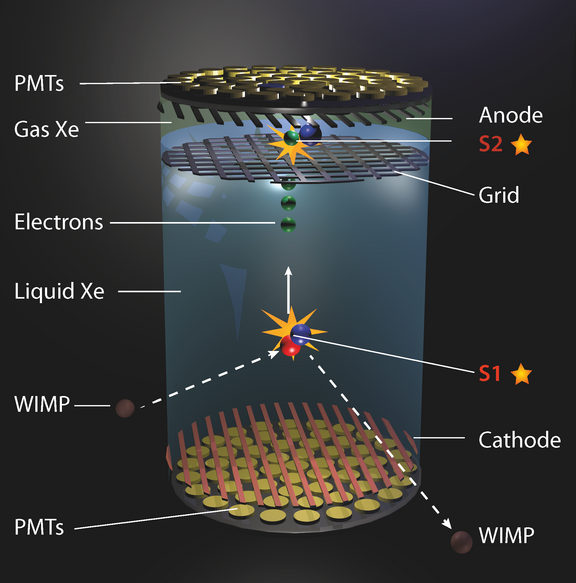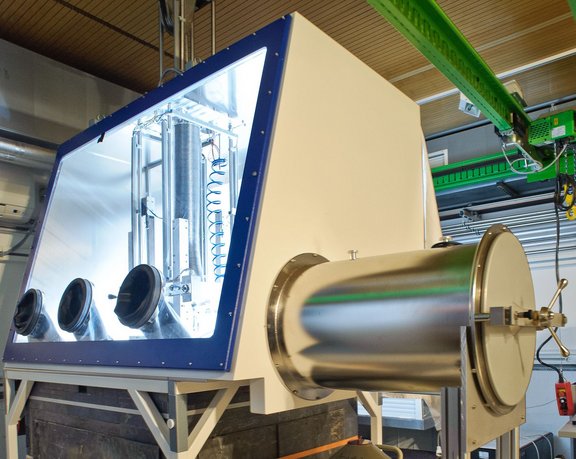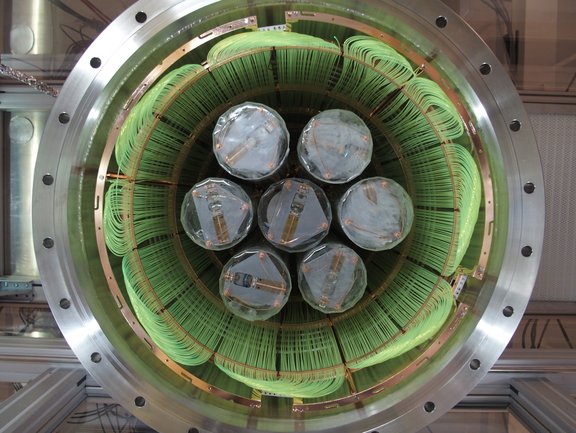Dark Matter – Structure Forming Agent in the Universe
Astronomical observations such as galactic rotation curves, gravitational lensing at galaxy clusters or the cosmic microwave background suggest, that the Universe consists to about 27% of dark matter (DM), while the fraction of ordinary visible matter is only about 5%. The remainder is the mysterious dark energy which is made responsible for the acceleration observed in the expansion of the Universe.
From a theoretical point of view, weakly interacting massive particles, called WIMPs, are promising candidates for dark matter, since they should have formed in the early Universe in the required amount and since they are proposed in – anyway required – extensions of the Standard Model of particle physics. But MPIK researchers also study other solutions motivated by other theoretical aspects. Examples are “axions”, “sterile neutrinos” or particles only interacting gravitationally. Furthermore, combined analyses and interpretation of different experiments and embedding candidates into consistent theoretical models aim at a global picture and at resolving controversial results.
A division at the MPIK is involved in the direct search for WIMPs with the XENON experiments in the Gran Sasso underground laboratory in Italy which use ultrapure liquid xenon as the detector medium. The detectors are able to measure in a correlated manner the combination of scintillation light and ionization emerging from the expected rare interactions of WIMPs with xenon atoms. XENON1T reached the highest sensitivity of such experiments deeply probing into the expected parameter regions where WIMPs and other dark matter candidates are expected, but hasn’t so far seen a signal. This high sensitivity made it possible to measure, by the way, a half-life of unimaginably long 1.8 × 1022 years for the double electron capture in 124Xe. An upgrade to a larger detector, XENONnT, with a three-fold active xenon mass and using the same infrastructure is nearing completion and will lead to a ten-fold sensitivity increase.
In addition, the H.E.S.S. telescopes look for high-energy gamma rays, produced by the annihilation of dark-matter particles in the DM halo of the Milky Way.
Low Level Techniques
Highly precise low-level techniques are essential for experiments looking for very rare events, where identification and reduction of the background plays a key role. At the MPIK, there is a long tradition and a lot of expertise in that field. The Institute’s low-level underground laboratory provides shielding against cosmic rays and thus offers very good conditions for detector development for low-background experiments. Highly sensitive gamma-ray spectrometers and very pure miniature proportional counters serve to check the radiopurity of materials and are the heart of assay techniques for very low concentrations of radioisotopes.
Among the most notorious contaminants are the natural radioisotopes 222Rn and 85Kr, for which various world-leading screening, measuring and reduction techniques are employed. The “Auto-Ema” system extracts fully automatically the radon outgassing from solid materials allowing for its sensitive measurement and the selection of suitable detector materials. Rare-gas mass spectroscopy was pushed to ppq sensitivity which allows, for example, to control 85Kr in Xe to the level of 10–23. Novel surface coating technologies are developed in order to push the backgrounds to unprecedented levels and to be most sensitive to dark matter.
Neutrinos – Particles with Striking Properties
Neutrinos are electrically neutral elementary particles of tiny mass which occur as three different types, so-called flavours. Besides photons, they are the most abundant particles in the Universe, but we don’t notice them as they interact only rarely with matter and penetrate it nearly without hindrance. Thus, highly sensitive detectors with excellent shielding against background signals are required to detect them.
When a neutron inside a nucleus beta decays to a proton and an electron, also an antineutrino is released and the element with the next higher atomic number forms. Some atomic nuclei, one of them the germanium isotope 76Ge, are not subject to the single but instead the double-beta decay: two neutrons are decaying at the same time with emission of either two or possibly no neutrino. The GERDA experiment searched for the neutrinoless double-beta decay in pure germanium crystals highly enriched in 76Ge. Neutrinoless double-beta decay, which is well motivated by theory, is an extremely rare event. Until now, no evidence for the decay was found – only that its half-life in 76Ge must be at least 1,8 × 1026 years. The successor project LEGEND-200 is based on GERDA with a significantly higher 76Ge mass which will improve the sensitivity considerably. A signal would prove that neutrinos are their own antiparticles, so-called Majorana particles, making it possible to deduce their mass.
For the rest mass of neutrinos only limits and differences are known to date. Other experiments to determine the neutrino mass rely on the capture of an electron by a proton in a nucleus. Therefore, the knowledge of the exact mass difference between mother and daughter nucleus is necessary. A group at the MPIK is performing such precision measurements.
The three neutrino types (electronic, muonic and tauonic flavour) periodically change this property (“neutrino oscillations”). Therefore, with increasing distance from a nuclear reactor, which is a strong electron antineutrino source, the number of these neutrinos detected decreases. This way, besides other experiments, Double Chooz could verify that all oscillations take place and make precise measurements of their parameters. However, many experiments in the vicinity of nuclear power plants detect overall about 6% less neutrinos than expected. The STEREO detector tries to find out whether sterile, i. e. non-interacting, neutrinos might be responsible for this reactor neutrino anomaly. The segmented detector measures electron antineutrinos by means of a liquid gadolinium-containing scintillator. A changeover to sterile neutrinos would become visible in their energy spectra.
The CONUS experiment also uses reactor neutrinos to investigate the coherent neutrino-nucleus scattering – scattering of neutrinos at the nucleus as a whole. Highly pure germanium detectors with very low energy threshold measure the tiny energy transfer due to this scattering process, which, however, is significantly more probable than the interaction of neutrinos with electrons.
Division Mertens Division Hinton
Division Blaum Group Lindner
Are Neutrinos Majorana Particles? - GERDA/LEGEND-200 (pdf)
Double Chooz: The Third Mixing Angle of the Neutrinos (pdf)
STEREO: Are sterile neutrinos the explanation for the reactor antineutrino anomaly? (pdf)
CONUS: Detecting coherent neutrino-nucleus scattering (pdf)


